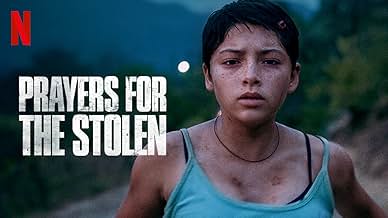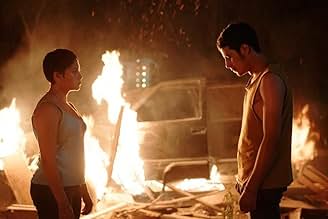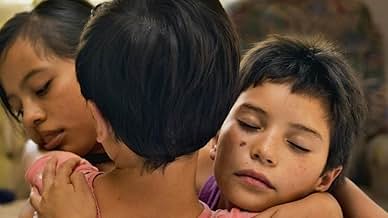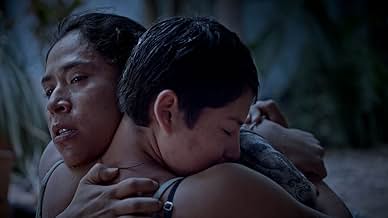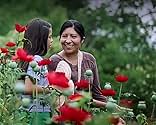NOTE IMDb
7,3/10
4,4 k
MA NOTE
La vie dans une ville en guerre vue à travers les yeux de trois jeunes filles sur le chemin de l'adolescence.La vie dans une ville en guerre vue à travers les yeux de trois jeunes filles sur le chemin de l'adolescence.La vie dans une ville en guerre vue à travers les yeux de trois jeunes filles sur le chemin de l'adolescence.
- Réalisation
- Scénario
- Casting principal
- Récompenses
- 23 victoires et 36 nominations au total
Avis à la une
When I went to see this movie, I knew it was gonna be tough, but I didn't imagine it to make me cry that much. The story really goes to the heart.
Also, the child actors did a wonderful job!
Also, the child actors did a wonderful job!
Horror, even the weird and most brutal films are just that, scary films. Noche de Fuego, based on Jeniffer Clement's "Prayers for the Stolen" is a radical departure from films that tackle the world of drugs and its consequences. Tatiana Huezo's film is an introspective into the life of three children as they grow in a world of violence in the mountains of Mexico where most people work in the world of opium harvesting. Harrowing and crude, the film goes into the depths of humanity, seen from the eyes of three young girls who fear the possible threats of only "living" as kids. The performances are stunning. The casting is superb. The DP created a visual masterpiece. With Tati at the helm, this rollercoaster of a film, will keep you nailed to your seat as it will be engraved in your mind for years to come. At Cannes, the film had wild reviews but, above all, an audience who couldn't believe what they experienced through the first Festival that chose it. A complete success!
Tatiana Huezo Sánchez who is best known for her documentaries, turns her attention to fiction with a coming of age drama based on Jennifer Clement's novel of the same title. It tells the story of Ana and her two best friends who discover a shocking reality - and a hostile world amidst the drug trafficking in Mexico. It gives a personal touch to something we hear at a distance on the internet. From the first moments of the film, Tatiana chooses to film this through the details, her camera focussing on the minutiae of the environment. She plunges us into an peaceful atmosphere, behind the lush green setup, we feel a discomfort and a lively tension underlying between the villagers. They depends on poppy harvest to make ends meet. There are semi-detached houses with hiding place and girls are made to sport boyish haircuts to escape from the eyes of human traffickers. There is absolutely no hope for the little girls and they tend to get worse as time goes on.
Initially, I was just expecting another usual documentary with realism tag, while storyline does follow the formula, its the treatment that appealed. It has a lot more than one would expect. It seems like a tearjearker war film, but when you dive into it you'll likely see a different pov. The pacing is easy and there is no rush on Tatiana's behalf to get to 'the story', as it were, but rather a strong sense of atmosphere and indulges the viewer through this lack of urgency. It contains an atmospheric and evocative cinematography by Dariela Ludlow Deloya. It is supported with subtle score by Jacobo Lieberman and Leonardo Heiblum. As well as adequate sound design by Lena Esquenazi.
Overall, it is a great proof that this film depicts childhood and adolescence of three girls is by no means exaggerated. It's blends early Jorge Silva, Marta Rodríguez, Alanis Obomsawin's style and is almost like a companion piece to Identifying Features (2020) and Birth Certificate (1961); both thoroughly bleak and does scream for help with no chance for hope.
Initially, I was just expecting another usual documentary with realism tag, while storyline does follow the formula, its the treatment that appealed. It has a lot more than one would expect. It seems like a tearjearker war film, but when you dive into it you'll likely see a different pov. The pacing is easy and there is no rush on Tatiana's behalf to get to 'the story', as it were, but rather a strong sense of atmosphere and indulges the viewer through this lack of urgency. It contains an atmospheric and evocative cinematography by Dariela Ludlow Deloya. It is supported with subtle score by Jacobo Lieberman and Leonardo Heiblum. As well as adequate sound design by Lena Esquenazi.
Overall, it is a great proof that this film depicts childhood and adolescence of three girls is by no means exaggerated. It's blends early Jorge Silva, Marta Rodríguez, Alanis Obomsawin's style and is almost like a companion piece to Identifying Features (2020) and Birth Certificate (1961); both thoroughly bleak and does scream for help with no chance for hope.
A bittersweet innocence exists among a group of young girls growing up in a drug-controlled country. One viewing of this excellent film will convince even the most stubborn-minded of the main reason that some of Mexico's inhabitants are fleeing to America to seek a better life.
Yikes but this is quite a difficult film to watch. It's centred around three teenage girls who live amidst the poppy fields of Mexico. "Ana" (Maria Membreño) "Paula" (Alejandro Camacho) and "Maria" (Giselle Barrera Sánchez) try to live their lives as normally as they can, but the fact that their school teacher is leaving because he won't pay protection money to the drug pedlars gives us some indication of the society in which they live. Indeed, it's this teacher who raises the issue of a missing girl - and that enlightens us to the fact that once they reach a certain age, these young women have other "uses" and nobody dares speak out about it. The chronology flits between the current life of these three and their younger childhood and illustrates that for them, there is little hope of change unless they are prepared to leave - but that they don't want to do with out each other or their mothers (the fathers don't feature at all in this drama). The rather courageous role of motherhood is really well exemplified by Mayra Batalla's contribution as "Rita". A woman who treats her daughters first menstruation with a dread that the young girl does not yet appreciate the significance of. It's a beautifully photographed vicious circle, with the emphasis on vicious. There are attempts at government interventions, local troops stationed and helicopters depositing toxins on the flowers, but the thrust here from director Tatiana Huezo is of a cycle of depressing and dangerous inevitability that it is difficult to see a way out of. The three young actors perform evocatively here offering us quite emotional and poignant characterisations. They are not simply going to give up - but it's not that simple. Harrowing, yes, but it's clearly been written and presented offering hope for the girls and to raise some awareness of the fact that as long as the West keeps buying the stuff, these people will live in a modern day slavery that turns your stomach.
Le saviez-vous
- AnecdotesOfficial submission of Mexico for the 'Best International Feature Film' category of the 94th Academy Awards in 2022. It made the shortlist but did not end up nominated.
- Bandes originalesCariñito
Written by Ángel Aníbal Rosado
Performed by Zindu Cano, Vivir Quintana, Alejandro Díaz, Leo Soqui, Rodrigo Garibay, Alfonso Figueroa, Leonardo Heiblum and Jacobo Lieberman
Meilleurs choix
Connectez-vous pour évaluer et suivre la liste de favoris afin de recevoir des recommandations personnalisées
- How long is Prayers for the Stolen?Alimenté par Alexa
Détails
- Date de sortie
- Pays d’origine
- Sites officiels
- Langue
- Aussi connu sous le nom de
- Prayers for the Stolen
- Lieux de tournage
- Sociétés de production
- Voir plus de crédits d'entreprise sur IMDbPro
- Durée1 heure 51 minutes
- Couleur
- Rapport de forme
- 1.78 : 1
Contribuer à cette page
Suggérer une modification ou ajouter du contenu manquant





